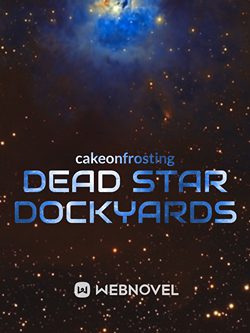
From Left to Right
The Hearse (IFV-1) [Model 1 Infantry Fighting Vehicle]
Fargo (UV-GP-1) [Model 1 Utility Vehicle - General Purpose]
Hyena (SV-1) [Model 1 Squad Vehicle]
Mehmed II (MA-IFS-1) [Model 1 Mobile Artillery - Indirect Fire Support]
Suleiman (MA-A/C-1) [Model 1 Mobile Artillery - Assault/Siege Cannon] {Uses Castille Chassis}
The Trawler series of Cargo ships found their origin not in the need to transport large amounts of cargo, but instead out of desperation to move as many people as possible in as short a period of time. Indeed, the vast majority of the Nekh descendants owe their lives not to the galleys and remes of the Holifanians, Bulsarzians, or even those lent out by the Arboreal Maiden herself, but to the humble Trawler.
This ship, bulky, blocky, and boring, could stuff nearly 3.5 thousand individual Nekh inside of it. Those Nekh were, of course, not very comfortable, but they were alive. With four interior stories and a high-intensity Recursive Split Generator, this ship was the second class designed and built by the Terran Empire. That said, it was not of a traditionally satisfactory build quality.
Indeed, the Trawler Mk1 was a rushed project, and while some have been preserved as historical pieces at the behest of the few million Nekh survivors as religious artifacts, many were scrapped in order to recover some of the materials for higher performance and higher quality ships. Mass interstellar transportation was not something affordable at that period in time.
That said, it was not designed solely for evacuation work. The panels along the upper side and rear panels could open, releasing a satellite to be used for reconnaissance and surveillance of their routes, and the seating arrays installed for the Nekh to sit in during their twelve day journey could be easily removed to expose an expansive if somewhat limited cargo bay. The humble Trawler was also the first commercial ship of the Terran Imperial Trade Corps.
Just because the Trawler was a peaceful vessel does not mean that it wasn't dangerous. In fact, that could not be farther from the truth. For the time it was in service, the Trawler was the second most lethal ship in existence, ranking just behind the Emperor's own 'Pegasus'. The reason for this lies in it's armament, the Omni-Turret.
While it only had one of these now notoriously lethal weapon concentrations, proudly protruding from the top of the ship's forward quarter, it was not to be trifled with. Even the smallest of the weapons contained within, the thirty millimeter autocannon, was more than capable of dealing with the wooden ships of the day.
It also sported a pair of 100 millimeter rifles, incredibly useful for dealing with larger ships, however even those paled in comparison to it's mightiest feature. The Variable acceleration Rail guns. These weapons were only installed out of fear, fear that there might really be something that required their use.
The Trawler continues to this day as a faithful civilian and cargo transport craft, a reliable source of transport for those unwilling or unable to purchase tickets for faster or more luxurious ships, its looming presence a reminder of the herculean task the first generation of Trawlers undertook in service of the Emperor.
Model Here: https://a360.co/3S9rB3A
The DD-1 Fishtail was the first 'true' combat vessel of the Terran Empire and represented the Emperor's adherence to the principles of the Jeune E'cole in his defense of Terran Space. Sitting at roughly 80 meters long, 36 meters 'wide' at the tail, and 10 meters 'tall', the Fishtail is very small for a destroyer. As a matter of fact, by dimensions alone it fits into the category of frigate.
The reason for this deviation from standard is actually quite a bit more simple than it seems - the Fishtail was not designed as an escort or patrol craft. Those two jobs were and still are staples of the Corvette and Frigate classes of ship, jobs the Fishtail is still entirely capable of performing of course, it just isn't limited to those duties. Or at least it wasn't.

For a crew of only twenty this ship seems pretty big, and it is, however it could be (and has been) operated by as few as ten. This goes beyond the incredible amount of automation inherent in it's design, the storage space for this ship stands as one of the most disproportionate in the Empire's history. Most of it was allocated to food and water, though a few models (the DD-1/1 series) were constructed to hold 'spoils' instead. It should come as no surprise to learn that those models were to be part of the Jakobi raider unit.
The Fishtail was not the type of ship that was dependent on constant convoy resupply like later destroyer designs. The Fishtail was a ship designed to operate independent of a supply base for extended periods of time, scouting deep into unknown territory and enacting blockades on planets and shipping routes for long periods of time.

Given the situation of the time period, determining whether or not the Fishtail should be considered heavily or lightly armed is something of a subjective stance. On the one hand, it did carry 4 500mm Blunderbuss turrets on the head, as well as 4 3x100mm Triple Hundred turrets on the rear. For a long period of time this was a considerable armament, more than capable of handling any threat that came it's way. However, this armament (with the ammunition available to it at the time) wasn't even a threat to the Light Cruisers used as mobile command centers for invasions and blockade management.
List of production models with major design changes -
/2 - moved turrets away from the main body. Measurable decrease in lifespan of turret rings noted for no significant gain in combat performance.
/3 - changed plating on 'fins' from symmetrically angled plating to circular, marginal increase in ammunition capacity for marginal increase in cost. Concerns about Shot from Blunderbuss making contact with new plate raised, no incidents of such reported. Deemed plausible, though extremely unlikely.
/5 - updated RSG, updated SSD, reduced storage capacity
/6 - experimental design, never mass produced. Served as test bed for features and systems aboard DD-2
/#-1 ('Cloud' Variant) - replaced all Triple Hundred turrets, all eight slots made into Blunderbuss mounts.
/#-2 ('Pistol' Variant) - replaced all Blunderbuss turrets, all eight slots made into Triple Hundred mounts.
/#-3 ('Wonderland' Variant) - switched locations of Blunderbuss and Triple Hundred turrets.
/#-#1 ('River' Variant) - all Triple Hundred turrets replaced with "Twin Fifty" rapid fire autocannon turrets.
/#-#2 ('Shaker' Variant) - all Blunderbuss turrets replaced with 200mm High Precision Assault Cannon turrets.
/#-#3 ('Winter' Variant) - All Triple hundred turrets replaced by Twin Fifty turrets, all Blunderbuss turrets replaced by 200mm HPAC turrets.
A ship with the model designation DD-1/3-33 would be referred to as a 'Model 3 Fishtail, Winter Wonderland Variant'.
A ship with the model designation DD-1/5-01 would be referred to as a 'Model 5 Fishtail, River Variant'.
Model Here: https://a360.co/45KcBfz
UES Calibration was a C2/3CV class fleet carrier that had a reputation as the posterchild for innovative strategies and tactics among the United Earth Administration's navies. The model above has all doors removed so that the dimensions of the hangars can more easily be felt.
UES Calibration, the same as the rest of the C2/3CV class, was the last run of fleet carriers to sport the bow hangar. This bow hangar was implemented as it was theorized that the use of a magnetic launch system would increase the operational efficacy of its deployed craft. Unfortunately, this proved to be less than ideal for a multitude of reasons.
For one, rotating a ship with such a large moment of inertia along its long axes is a massive waste of time and energy in combat. However, this becomes a further detriment when the fact that an incredibly weak section of the hull, the hangar doors, are exposed to the brunt of enemy large caliber fire for an extended period of time.
As such, the designers ended up unwittingly sacrificing key components of structural integrity traditionally accounted for in the thick armor plating sealing the front of the ship while not achieving anything meaningful. Overall, the amount of hangar space for its mass was lower than predicted owing to the concrete that needed to be filled into the connecting void between the bow and core hangars.
(The rest of the Calibration's summary can be found in the subreddit here, https://www.reddit.com/r/DeadStarDockyards/comments/x5gdvq/the_calibration/?utm_source=share&utm_medium=web2x&context=3)
Model Here: https://a360.co/3QvsPVs
The HF14/4 'Broadhead' was the final iteration in the Arrow series of Heavy fighters. Characterized by a relatively compact design and a high forward acceleration for its class, the Broadhead was nothing but a headache for its pilots and targets alike.
The Broadhead was notorious among its operators for the ever so slight rotation induced by the primary thrusters, a defect that could be remedied somewhat by field and factory modification but could never be fully fixed. Upon revisiting the blueprints, it was found that when stability calculations were done, a full load of fuel, ammo and the pilot was not considered.

The induced spin was not a fatal flaw so it was still pressed into service, however the need to constantly expend fuel to keep a steady course reduced its expected combat time and somewhat affected its acceleration. Fortunately, this ship was not designed with a sustained dogfight in mind.
The rest of the entry and additional pictures can be found on the subreddit, here -
(https://www.reddit.com/r/DeadStarDockyards/comments/xne9o2/the_broadhead_class_heavy_fighter/?utm_source=share&utm_medium=web2x&context=3)
Model Here: https://a360.co/3s5lUcl
The MS/BS Series 1 Domino was a strike craft characterized by its departure from the standard design doctrine of the time in more ways than one. The first, most obvious deviation from its peers was the complete and total lack of aerodynamic qualities.

In the design stages, this actually presented some problems. In comparison to previous generations, it was found to be far easier to detect with sensor equipment to the point where questions were raised about the combat efficacy of such a design. The lead designer, afraid her project might be unceremoniously canceled, made some last minute changes and doctrinal suggestions in a bid to regain the attention of the higher ups.

Stealth would be abandoned, and the ship would only be armored on the faces expected to take fire. To further enhance the Domino's survivability, the thrusters were made to swivel on their mount so that the armor profile of the Domino in the direction of expected fire could be maximized. This newly developed 'Bevel' mount was actually a repurposed elevation drive for an old cannon model.
The rest of the entry and additional pictures can be found on the subreddit, here -
https://www.reddit.com/r/DeadStarDockyards/comments/xmdrnx/the_domino_class_strike_craft/?utm_source=share&utm_medium=web2x&context=3
Model Here: https://a360.co/3Q5tfjS

To give an accurate portrayal of dimensions and shape as well as make the location of the railguns clear, the surface of the Noah has been made to reflect light. In actuality, the coating and passive energy field surrounding its surface will make it pure black. You would see nothing but a dark void.
The Noah is 50 meters long, 25 meters wide, and 15 meters tall. To give an idea of how this would appear in reality, a cylinder in the rough dimensions of the average humans is present for scale standing at 2 meters tall.
The Noah does not conform to the traditional pre-introduction Terran design standards. It had dimensions more akin to a corvette or frigate, sensor equipment on the level of a destroyer, and the armor of a capital ship. While extremely limited in ammunition stowage and less effective owing to relative mass, it also sported a pair of Capital Class Railguns. In addition to all of this, it had handling characteristics usually only seen in Interceptors and was practically unnoticeable to most methods of detection that existed at the time of its inception.
Understandably, it is incredibly expensive as a result. By the metric of mass to cost, it stands as the single most expensive ship ever developed and constructed by a significant margin, with many questions about its performance capabilities left unanswered even at the time of its dismantlement.
An important lesson that was learned is that the Noah, and any other ship like it, should not operate by itself unless extreme circumstances call for it. The nature of stealth means that it is unable to fire upon an enemy without revealing its location, so the railguns will more than likely end up unused unless there is a pressing need to dispatch a dangerous target.
Similarly, it was learned that having a separate ship far closer to the enemy with more accurate sensor readings acting as a combat controller could result in a devastating advantage that even the most calculated and advanced battle tactics could not make up for. Increases in accuracy and effective range aside, the ability to more precisely direct strikes of ships, deployable craft, and missiles means that a more effective defeat in detail of enemy forces can be achieved.
All in all, it served well in its combat roles, but its duty as the vessel to maintain the Terran race remained a more pressing concern in its design.
New technologies brought about in the short time that Split was made an available resource for use could certainly increase its efficacy in combat, as well as make sure that the designated survivors would make it to the Oberlux, methods that did not rely on its use would be necessary to ensure that industry could be built up in a timely manner once it had been destroyed.
The railguns were not added as a means for offence, but as a way to guarantee that key elements could be separated and isolated in a plasmatic state if chemicals traditionally used to refine them were not readily available. A powerful Atmospheric Containment Field Generator was installed to assist in this process, as well as Cutter lasers, the only lasers small enough and powerful enough to fit on the Noah and heat the necessary materials to the required temperature.
Additionally, an emotionally intelligent computer system was developed alongside the Noah in order to assist its inhabitants in a number of ways, as well as handle the building of industry.
This 'do-it-all' nature of the Noah was not without sacrifice.
Despite its size, it only really had one room, making it fairly cramped if one were to be kept inside for a significant period of time. The detriments of this were recorded by the computer, named ARCS, and included a variety of side effects ranging from the decay of physical health, extreme mental stress from lack of stimuli, and general boredom and dissatisfaction.
It also lacked many parts considered to be prerequisites for ships of its size. Landing gear, for example, was absent on the ship. When this fact was combined with the knowledge that the only way in or out was through the bottom, it became very clear that this ship wasn't operable unless you could perch it in such a way that the bottom was free from obstruction.
This issue was mitigated in the Terran Carrier Calibration by installing a series of robotic 'arms' that would secure the Noah a good three or so meters above the ground so that it could be accessed without issue. On the Oberlux and in the safety of the Great Csillacra, branches were used instead.
Another issue with the Noah was in the way it was meant to maneuver. Unlike other ships at the time, the Oberlux relied exclusively on then a prototype propulsion system, now referred to as Split-Stream Rotors, to move about. Internal gyroscopic motors, those often used to turn ships to save fuel, were completely absent, meaning that the addition of any rotational momentum would remain until it was counteracted.
Model Here: https://a360.co/3tPcYbu
The Pegasus was the first void-worthy ship the Terran Empire completed construction of, the unique situation and limited information the Emperor and Empress found themselves facing required a rather unique design. They required a ship that could do 'everything and nothing else' with a limited supply of materiel. It needed to have a heavy and diverse enough armament to deal with any potential threat they would run into, while also having enough internal space to carry large amounts of material and provide an ample space for up to ten people to live comfortably. This ship also had to be capable of landing in a terrestrial environment as well as capable of towing large extra-terrestrial structures around without compromising the integrity of the hull.

This list of requirements meant that the surface area of the craft would be a resource under intense competition from all of the relevant components, a great source of restriction being the requirement of terrestrial landing.
One of the methods devised to maximize the available space was an old Terran design concept known as a telescoping barbette, a mechanical system that retracts a turret inside of the barbette. Initially devised as a means to shield the vulnerable and thinly armored turrets of lighter ships from space-borne debris, it finds new use here as a means to bring the top of the turrets close to the hull of the ship. They are not fully telescoped, long barrel and high energy kinetic weaponry being unsuited to that trait, but they retract far enough that it opens up space for magnetic 'hooks' to be attached to the surface around them. The bottom of the ship is still unavailable to the turrets owing to the need to land, so most of the small telescoping turrets were concentrated on the top side.
Why were they not placed on the sides of the ship? The simplest explanation would be gravity. Telescoping barbettes do not play well with forces directed perpendicular to their axis of movement, certain components like hydraulics being extremely prone to damage if exposed to such forces for an extended period of time.
The primary armament of the Pegasus is neither the small turrets of four 'Triple Hundred's and four 'Blunderbuss's, nor was it the railguns, but instead the four 500mm 'PUNT' Guns mounted on the OMNI turret platform on the underside bow of the Pegasus. In essence, they are longer versions of the Blunderbuss system, however they are much deadlier. Their payload is much heavier with an equal amount of pellets of a larger size and a much tighter spread. One shot is estimated to be the effective saturation equivalent of three minutes of fire from a single Triple Hundred system. The two cavities in the front of the platform are launch bays for various deployable objects, be it probe or mine.
The flat rectangular plate on the otherwise curve upper frontal glacis of the Pegasus is not some sort of observation deck, it isn't even made of a see through material. Instead it is the place where the primary anchor (or foot) of the slipway that constructed the ship would be attached to. A large contiguous and flat portion of metal with enough of an angle towards the front to guarantee that the structure would not slip during transport, an angle and area calculated based on the maximum forward thrust the Pegasus was capable of. It should be noted that this patch of steel was considered to be a week point carved out of the existing frontal plate. Despite being almost 100mm thick at it's weakest, it was considered thin enough to be dangerous should the Pegasus ever run into something headfirst.
The cargo bay is the only way in or out of the ship's interior. This interior space had sufficient space to stow the first generation LWV, or 'Land and Water Vehicle', for use in a terrestrial climate. It had limited range of about 100km on flat dirt roads (250km round trip on asphalt) and maximum land speed of 40 km/hr and water speed of 10 km/hr under ideal conditions. This seems shamefully limited in comparison to most other vehicles, however the purpose was to transport large quantities of materials over short distances with ease and provide shelter in harsher climates. Should ever there be a need to move beyond the LWV's range, the expectation was that the Pegasus would pick it up and move closer to that location.

At the time of construction it was the biggest ship in the galaxy, outsizing even the most expansive of galleys, and provided ample experience and data with regards to Split for the Emperor to design future craft.
Model Here: https://a360.co/4746XGj
The Galley, often also called the Reme or 'Vessel of Old', was the primary method of interstellar travel before the Terrans introduced the much faster and more efficient 'propulsion' focused craft. It featured sails that interacted with the 'Solar Winds', a phenomena now known to be the flow of split in the space surrounding a star 'catching' in the fibers of the sails.
These ships most often featured three types of sails, Top sails, Keel sails, and Oar sails.
The Top sails are fairly self explanatory, the sails attached to the masts on the top of the ship. They, paired with the Keel sails, served as the primary source of forward movement for these vessels, and often hosted the Bannus of the nation or merchant association they represented. These sails were only capable of limited rotation about their masts, thirty degrees in most cases, as too much force perpendicular to the keel risked snapping the mast.
Keel sails extend from the bottom of the ship, often retracted into the ship's or stowed into some hatch when landing on terrestrial oceans. They are basically Top sails, just on the bottom. This bottom is flat, and is vaguely representative of a second main deck. Indeed, sailors are needed on this side to control the Keel sails and watch for ships below.
Oar sails are those which extend out of the side of the Galley and are triangular in shape. As one might grasp from the name, they can be used as oars to pull the ship forward should the Solar Winds lull for any reason. Most of the time they are use to facilitate motion at angles that would not make sense for the Top and Keel sails to catch wind at.
In order to facilitate meaningful motion, sails alone are not enough. Without the anchoring effect of dagger boards, ships would be at the complete mercy of the Solar Winds, left to waft downwind at all times.
Dagger boards are planks of wood or bone specially crafted to interact with the 'Void Sea', one of many separate 'dimensions' of split. This dimension in particular relatively static, the 'sea' anchored relative to the nearest gravitational body.
One might think of the relationship between dagger board and sail to be the same as the traditional maritime sailboat's dagger board and sail work. The dagger board sticks into the water, the sea, providing both an element of (momentary) rotational stability as well as enough lateral resistance to keep the boat moving forward in a straight line along the bow.
Of course unlike the sailboat, these boards must be fashioned in such a way that three dimensional stability is achieved. This usually takes the form of a long structure going down the length of the ship that has a cross section that looks like a '+', which is known as a keel.
A set of ancillary dagger boards fore or aft serve the purpose of turning the ship, and are therefore called 'Rudder Boards' while the set of boards that control the rotation around the long axis are known as the 'Wing Boards'.
For the most part dagger boards are internal, while sails are external by nature.
Its a space shotgun designed to eliminate wooden ships in as little a time as possible. Does it need further explanation?
Model Here: https://a360.co/46ReLeL
The Triple Hundred Turret was designed by the Emperor to be the counter to 'hard' threats in a time when soft targets were plentiful. As the name suggests, it is a weapons system that couples three 100mm rifles that 'rapid fire' by way of sequential loading. Its initial recipient, the Pegasus, was fashioned to make use of them as a means to deter any potential 'small but solid' targets.

Given the small caliber and high velocity, it was wholly unsuited for attacking galleys, damage to the wooden hulls being considered limited even when explosive shells were fired. Such lumbering targets were better left to the Blunderbuss turrets, which would eliminate most of its victims in a single shot by way of killing the crew rather than disrupting the structural integrity of those designs.

Instead, this type of weapon was better suited to offensive point defense and neutralizing those space-faring creatures with slightly tougher exteriors until such a time that 'modern' space ships were developed by other powers. The capability to fire one round roughly every 1.1 seconds being incredibly lethal to the lightly armored ships of that era. Eventually this design was phased out in favor of specialized weapons, those with higher fire rates and better tracking, though it is still widely used amongst the Empire's many merchants due to it's dual-purpose capability.
Model Here: https://a360.co/46IWqAH
The Castile Heavy Duty Mobile Platform was designed for the Suleiman 200mm Assault Cannon, however ARC recognized the potential utility that a tracked vehicle with a lot of torque and a particularly strong rear suspension could provide.
The Castile featured a very large center mounted diesel engine, purposely placed there to allow for the drivers to have a front view and the rear to be left open for all of the supporting structures that such a massive and powerful weapon would require. This meant that without that weapon, that space was open for other support structures. It should also be noted that, unlike it's fully loaded Suleiman form, the Castile can actually be quite quick due to the removed weight, reliably reaching a speed of 20 m/s (72kph) on a variety of level terrains.
In essence, the Castile was the perfect platform for any job that required a lot of heavy lifting, towing, or space for a large object or crew complement. The standardized and simple form of the Castile would make maintenance on a greater number of vehicles similar, a great relief for the relatively inexperienced and undeveloped Mechanic Corps of the time
Vehicles that utilized the Castile platform include but are not limited to -
- Suleiman: 200mm Mobile Assault/Siege Cannon (MA-A/S-1)
- Ceuta: Heavy Duty Ammunition Ferry (HAF-1)
- Windsor: Heavy Duty Engineering, Towing, and Repair Vehicle (ETRV-1)
- Malbork: All-Terrain Mobile Medical Center (U-MC-2)
- Peles: Mobile High Capacity Power Station (U-PS-1)
- Bran: Heavy Duty Salvage and Rescue Vehicle (Not to be confused with an ETRV) (U-HSV-1)
- Tintagel: Mobile Command and Communication Center (CRad-1)
- Stirling: Mobile Drone RC Drone Launch and Control Center (RC/LC-1)
- Coolbanagher: Heavy Debris Clearance Vehicle (Dozer-1)
- Drogo: Mobile Construction and Reconstruction Vehicle (BOB-1)
- Bravo: Mobile Hazard Containment Vehicle (Hazard-1)
Model Here: https://a360.co/3tN18yL
The Model 1 Mobile Assault-Siege 200mm Cannon, named the Suleiman, was the Emperor's response to the prevalence of thick castle walls that he anticipated would be used by enemies to hole up in and halt his conquests. In contrast to the traditional design practice of constructing a suitable chassis with certain design parameters and compromising with regards to the primary armament, mobility, and protection, the chassis of the Suleiman, the Castile platform, was designed for the sole purpose of supporting the 8-inch cannon.

The Castile platform places a heavy focus on weight placed on the rear of the vehicle as shown above by a greater concentration of road wheels. This also means that it can handle the massive amounts of recoil from the 8-inch cannon better.
However even with this focus on the rear suspension, the balance was considered to be 'inadequate' for the Emperor. The Suleiman was incapable of climbing inclines greater than ten degrees without assistance as it would 'sit back' due to the weight. It was also a remarkably slow vehicle, reportedly reaching a maximum of 7.23 m/s on flat level concrete, the most ideal circumstances. Elsewhere, such as on plains, it could only be expected to reach the blistering pace of around 3 m/s. This is significantly faster than walking pace and definitely more mobile than a gun of this size could be expected to be towed, but it was still a bit too slow for the Emperor's liking.
To remedy this, the emperor employed a strategy now affectionately known as 'Logi-Hopping'. The strategic situation of the time had invasion forces fighting in multiple places at the same time across an incredibly vast patch of land. Logistic vessels, dropships and such, were still uncontested in the sky, and thus could roam freely. By organizing resupply operations and bombardment schedules together, logistic transports could be arranged to arrive at a Suleiman's location just as its bombardment was ending to transport it to the next location. Under optimal scheduling and with more than just a few lucky shots, one Suleiman Assault Cannon could turn as many as six city or castle walls into rubble in a single day.
Due to the size and weight of the cannon, as well as the recoil it generated, an elevation system was determined to be too fragile and too heavy for the work that needed to be done. The gun needed to be casemate, part and parcel of the vehicle as a whole. This didn't mean that it would be impossible to aim. Suspension aim would be expensive, and it would be necessary to turn in order to switch targets, but slight elevation angle adjustments could be performed by a plate that could extend from the rear lower glacis to push it upwards.
Additionally, this plate would help dampen the recoil and limit the rollback the vehicle experienced.
Speaking of recoil, the muzzle brake of the Suleiman did wonders to reduce it. However, it did present a few problems, especially for some of the first users of the system, the Nekh. This brake did not just redirect gasses out the side like most other ballistic weapons did, but instead directed them back towards the breech.
This reduces recoil more than the perpendicular brake as some gasses are pushing the barrel forward instead of backward, but that also means that a intense amount of hot and loud gasses are now headed towards the firing team. One of the Nekh's rather unique traits is their sensitive ears, so ear protection alone was not enough.
This is muzzle brake is the reason for the rather ugly and thick metal box encapsulating the breech. Contrary to popular belief, it was not meant to protect the crew and breech from enemy fire and the elements, but to protect them from the gun itself. The back of this box opened from the bottom, exposing the breech to the ammunition deposit slide of the Ceuta and allowing the crew to get in and out of the cabin using it as a ramp.
Model Here: https://a360.co/40esg5z
The Ceuta Ammunition Ferry was how the Emperor compensated for the Suleiman's lack of ammo stowage. It used as much internal space as it dared without skimping on ammunition safety, and the result is quite shocking. The Ceuta can carry a maximum of 448 powder charges or shells for the Suleiman's main gun, both having a height of 1.2 meters and a maximum diameter of 200mm.
Having two Ceuta's in one place was fairly rare though, each Ceuta being paired with a Suleiman, and they never carried their maximum load due to both ammunition limits and fears of it all being set off, so most would only ever carry up to 120 shots for a Suleiman, 120 shells and 120 powder charges for a total of 240 ammunition pieces, so just over half of full capacity.
This was believed to be enough to ensure that any wall would be destroyed enough to hinder enemy morale, though a few fringe cases did require that a Ceuta be taken to an ammo dump to restock.
Rapid reloading was facilitated by the ammo deposit slide that swiveled off the side. Heavy shells could be pushed along the slide right up to the breech, a welcome feature for a loading crew that would rapidly grow tired after lifting several hundred pound shells every forty seconds.
The gantry crane installed onto the Ceuta's superstructure would make lifting the shells out of the cache easier, a pulley with a magnetic cup could be attached to it so that the crew would not have to get into the box full of volatile materiel, though they often did anyways. The powder charges were light enough to lift out manually without breaking someone's back, so the smallest member was usually asked to dance on shells so that the gun could get reloaded faster. No incidents of accidental detonation were ever reported, though the safety of the act is questioned to this day.
Model Here: https://a360.co/49cgInK
The Model 1 High Mobility 150mm Indirect Fire Support Platform, named the Mehmed II, was the Emperor's first attempt at creating a weapon system which could mitigate the advantages that castle walls gave to enemy defenders. While it was, technically, capable of reducing segments of walls to rubble, it was considered a practical failure in that role.
It wasn't by any means a design problem, but instead a result of the Emperor's underestimation of the walls his forces would be tasked with demolishing. They were much larger and thicker than the Emperor had anticipated, meaning that the caliber the Mehmed II was designed with, 150mm, just didn't have enough power to do the damage it needed to.
The walls could still be demolished by the Mehmed II, the required time and ammunition expenditures were just too prohibitive for the speed at which operations were expected to be carried out. This lead to the development and introduction of the Suleiman 200mm Assault/Siege Cannon, a vehicle boasting a cannon 20 times as powerful, the spiritual successor to the Mehmed II.
This did not mean that the Emperor was just going to give up on the Mehmed II. Despite it's failing in the role of castle crushing, it was still a very capable weapon, one designed to be used a long time into the future. It was insufficient for castle walls, but 150mm of high explosive is still 150mm of high explosive, smaller structures and infantry concentrations were still extremely vulnerable, especially given the other systems on board.
In stark contrast to every other land vehicle produced at the time, the Mehmed II sported an autoloader for the primary armament. Capable of firing one round every six seconds, several shots could be put in the air before the first made contact with the ground. Firing solutions were handled by Arc through a satellite link that used GPS and meteorological data to guarantee accuracy and prevent friendly fire incidents, six seconds being enough time for the vehicle to readjust its angle for the next shot.
Internal maintenance was not to be handled by the relatively inexperienced mechanics of the day, but instead by a system of nanodrones controlled by the onboard computer. The wheels, large to avoid getting bogged down in mud, were not connect by axles. Instead, each was capable of turning independently and were all driven by their own separate electrical motor.
When targets were plentiful and threats few, the Mehmed found itself more than capable of controlling a battlefield well beyond the general abandonment of sword and spear, even if it's popularity declined in favor of more advanced systems. It was only upon the development of guided munitions by Coalition Forces that it was put out of service for good, the lifting of the Absconded Treaty rendering it horrendously obsolete.
Model Here: https://a360.co/497yf0j
The first Squad Vehicle to be adopted into the Terran Armed forces was the SV-1 Hyena. In hindsight, many consider this vehicle to have been an odd one, a hodge-podge of design elements not found in subsequent squad vehicles replacing elements most consider key to the role's identity. Indeed, this was one vehicle widely considered to be 'impromptu', and the vast number of field modifications applied to it were proof of that, but it performed its job exceedingly well nonetheless.
Fast, amphibious, and with an incredibly spacious interior, the Hyena could theoretically carry a full squad of ten across almost any terrain under almost any weather condition, and across small bodies of water with little issue. Lauded as reliable and easy to handle, the only complaints it ever received revolved around how ill equipped it was to actually support an active combat situation.
Despite support not being in the role designation, 'Squad Vehicle' still fell under the umbrella of 'Infantry Support/Fighting Vehicle'. In it's pure and unmodified state, it could neither support nor fight infantry. It had weapons, kind of, but they could not be used in an active firefight. Jerry-rigged variants found their way into the field, usually by way of tearing out one of the side windows and mounting a 10mm machine gun to the sill, but for the most part these vehicles dropped off their infantry before a fight and waited in the back.
Make no mistake, these vehicles were loved by those whose found themselves inside. They were the fastest available at the time and could chew through rough terrain better than one might expect, they were just . . . lacking. Naturally they were phased out once the reason for their lack of focus, sieges, had been 'figured out' and a purpose built vehicle designed for it.
If the demographic and educational state of the Terran Empire been different at the time, there is a very good chance that the Hyena never would have come to be. Even if the defenders did not have access to firearms, assaulting a city or castle would be a costly endeavor, the price being lives. Lives on both sides. Today this is a cost generally considered to be acceptable, deaths are to be expected in war, but it was not so at the time.
During those early years, the only real source of combat manpower available to the Emperor came from the Nekh and Holifanian populations. It should be known that a select few grateful souls from those conquered planets also volunteered themselves to the Emperor's service, but for the most part the burden fell upon the limited population of Nectar. Losses were to be avoided wherever possible, especially amongst the Nekh.
So how did the Emperor manage to take cities if fighting was out of the question? The answer was simple, he didn't fight. The prevailing strategy was to demoralize the inhabitants of such heavily defended structures to the point of voluntary surrender. The Suleiman, the penultimate bunker-busting tool of the Terran armed forces, would remove the feeling of protection those thick walls gave, but this frequently proved to be insufficient.
Enter the Laughing Sun.
This weapon, if it could be called such, was not one to be used in a destructive capacity. Only three disastrous incidents of fuse timing failures ever caused direct damage to structures on the ground, none of which were intentional. No, the Laughing Sun was designed to detonate in the air, at night, around 100 meters above whatever structure lay below.
With a warhead designed to create as loud of a bang as possible, it also created a persisting bright light. The light that persisted also created a sound, an ominous high-pitched humming that rapidly cycled in intensity. With a light so bright it could be mistaken for the sun, how the weapon got it's name should be no surprise.
The Laughing Sun would usually only be fired during the night, at least half an hour after dusk, in order to interrupt as many people's sleep as possible. One would be fired every fifteen to twenty minutes after the first, creating an environment that made sleep almost impossible for those close to the site of detonation. As each Hyena could carry eight of these tools of terror, it usually took around five to maintain the sleepless state throughout a single night. Twelve would be needed to make sleep throughout the day impossible.
One 'pack' or 'clan' of Hyenas typically consisted of 25 vehicles, so one unit could maintain the terror for two days before needing to be reloaded. Usually only one day was needed before the citizenry of a walled city forced a surrender while three were typically needed for castles given the higher level of discipline of soldiers. Some sieges took longer, weeks or even months, but these were acceptable delays.
This was a time when rockets were expendable and lives were not.
Model Here: https://a360.co/3FFi4JT
Behold! The mighty Hearse! Of all the vehicles the Emperor designed for frontline combat, this one vehicle stands out as appearing somewhat out of place. Yes, it is a car. It has been heavily modified in order to better handle the greatly increased weight and the stress of driving off road, but it is still a car at its core. More specifically it is a hearse, hence the name.
This does not mean that it should be taken as harmless.
The Hearse was chosen as the base for this weapon for a reason, that being the spacious interior. The weapon mounted to it, the Scythe, was particularly ammo-hungry. Even when carrying a full belt of 20mm ammunition, there was only enough for a few minutes of firing. During this time, anything standing in it's way would be subject to a steady stream of steel.
Model Here: https://a360.co/3QxC86n
The Scythe
Ammunition: 20mm Standard (early) cartridge - Solid Core and High Explosive rounds most common, 1 tracer round in every five.
Exit Velocity: 850-875 m/s depending on round.
Rate of Fire: 24 to 48 rounds per second depending on speed setting and model.
Barrels: 12, all 1 meter in length.
Effective Range: Depends on use, model, and selected fire rate - Air Targets ~ 2-3km
Ground Targets ~ 600m-1200m
By far the most terrifying weapon of the Emperor's early conquests, the Scythe was initially dubbed "The Dragon" on account of the fire that spewed from its mouth. This nickname was promptly changed. First used against a force of conscripted peasants arranged in neat echelons on an open field, the line of hot steel that left the barrels cut them down as if they were stalks of grain ready for the harvest.
Given the relationship of the Scythe to one of the Terran symbols of death, the operators of these weapons were soon dubbed "Reapers", a fitting name considering the vehicle these weapons were mounted to were called Hearses, the name vehicles used to transport the dead.
The sight on the Scythe was frequently referred to as "the single most useless feature of any weapon in the Terran arsenal" for good reason. Once the Scythe began to fire, adjustments could be made exclusively based on the tracers. The sight could be used to get an initial bead, but rarely would the shots actually land in the circle, the recoil and spinning of the barrels causing a considerable degree of deviation.
The Fargo, a general purpose truck more suited to use by civilians than a military fighting in an active conflict, but without the threat of return fire or a need to carry anything particularly heavy the Fargo proved to be more than enough. A simple design prioritizing reliability over everything else, the Fargo got it's name from a peculiarity in the language of the time, namely that the literacy level was fairly low. This truck didn't "go far", it was simply a "far go".
The Fargo was, at its core, a general purpose vehicle. It could transport troops, carry supplies, tow artillery, and mount a machine gun on the bed if it was really needed. Most of the time it was relegated to ferrying troops and ammunition from supply points to combat centers, but a sufficiently creative mechanic could modify it to accomplish a task the factory standard equipment didn't allow it to. Perhaps the most famous example was the addition of a mortar to the bed, packs of mortar equipped Fargos being quite a scary opponent for any enemy force thinking they were safe from direct fire.
The most famous aspect of the Fargo had nothing to do with its combat service. Most became familiar with the Fargo after the conquest of a planet was over. Every Fargo that was sent down to a planet to assist combat operations would be left there, never to return to space. There they would be used to assist in the construction and homogenization efforts.
Convoys of Fargos carried food imported from Nectar to the many hungry new citizens of the empire. Fargos ferried men and construction materials from place to place, assisting in building up infrastructure. Fargos carried hunters out to patrol and cull populations of monstrous beasts. Fargos were the backbone of the Empire's early industrial development.
Model Here: https://a360.co/3QxC86n
UNIT SIZES
Squad: Academy/Undeveloped <> 5-10 People | Modern/Developed <> 5-15 People
Platoon: A/U <> Not used | M/D <> 4-5 Squads (situation dynamic grouping)
Battalion: A/U <> Not used | M/D <> 200-500 People <> 10-26 Squads (alphabetic)
Regiment: A/U <> 50-100 People <> 5-10 Squads | M/D <> 2.5k-10k People <> 10-26 Battalions (alphabetic)
Brigade: A/U <> 250-500 People <> 3-5 Regiments | M/D <> 20k-50k People <> 5-10 Regiments
Division: A/U <> 1k-2.5k People <> 4-5 Brigades | M/D <> 100k-250k P <> 5-10 B <> 10-26 R
Army: A/U <> 8k-12k People <> 5-10 Divisions | M/D <> 1M-2.5M People <> 10 Divisions
Planetary Invasion Army: A/U <> Whatever they have | M/D <> 10M People <> 4-10 Armies
Note1: These are big fucking numbers, 10 million combat personnel in a single invasion army sounds excessive, but it is usually not enough. Planets are huge and they require a ton of people to both take and garrison. It also includes a number of logistics personnel, enough to make an army of their own, and dedicated garrison/development troops. There is also a need to cycle the frontlines, and because 'home' is planets away, they need to stay 'close' to not strain the logistical trains.
Note2: Because of the chaotic way in which certain armies are set up, particularly the mechanized forces which denotes unit size based on both personnel and vehicle numbers, the same unit 'size' may be used multiple times in an assignment order. Example below
PIV73MA4AD3CR5BA2GS3 - the assignment number of the tank from 'Sappho 3'
PIV73 = (P)lanetary (I)n(V)asion Army (73) - 15M p (15 armies, 8 Mech, 2 Aviation, 5 Garrison/Inf)
MA4 = (M)echanized (A)rmy (4) - 1M p (10 Divisions, 4 Armored, 5 Mobile Inf, 1 Recovery)
AD3 = (A)rmored (D)ivision (3) - 100k p (10 Regiments, 8 Tank, 2 Recon)
CR5 = Tank ((C)hassis) (R)egiment (5) - 10k p (10 Battalions)
BA2 = (BA)ttalion (2) - 1k p (10 (vehicle) Divisions, varied composition)
G = '(G)' Division [Greek Division] - 99 people, 25 Tanks split evenly into 5 platoons
S = '(S)' Platoon [Platoon Sappho] - 19 people, 5 Tanks
3 = Number (3) - 3 crew, 1 Tank
The 'lowest three' ranks of the assignment number are dictated by the number of vehicles in the unit, not the number of people.
The Significance of the Difference between 'Rifles' and 'Smoothbores'
The Appearance
To begin, I should first mentioned the physical differences between these types of cannon are, differences you should be able to pick out with your eyes.
The most obvious difference between the two is, of course, the rifling. If you have ever seen a gun's barrel, one that is hand held like a pistol or machine gun, you will notice these grooves on the interior of the barrel. This is what is known as 'rifling', and all firearms that have it are technically called 'Rifles' even when they aren't labelled as such.
Machine guns with rifled barrels are Automatic 'Rifles'. Anti-Materiel guns, Anti-Materiel 'Rifles'. Carbines, Short Barreled 'Rifles'. Sniper 'Rifles'. The list goes on. MOST infantry weapons are rifled, and for good reason. The rifling of the barrel does something very important, which will be discussed later.
Smoothbores (or Smooth Bores) do not have any sort of notching or grooving or notching in their barrels, save for small holes used for auxiliary functions such as those that utilize the gas produced by the explosives that drive the projectile.
Another difference is that rifled barrels will appear to be thicker than an equivalent caliber of smooth bore. This is primarily due to the fact that the caliber of the rifle is tied to the distance between the tops, "lands", of the rifling, which should be close-to-if-not-exactly the diameter of the bullet.
The second reason has to do with stresses caused by the exhaust. I don't want to bring this into a lecture about engineering, but because the grooves of the rifle form a type of gulley for the high pressure gasses to expand into around the bullet, there will be more stresses in those grooves. You might think of this as the difference between how a submarine resists popping under pressure and how a balloon resists popping while full. Steel, a solid, is much better resisting omni-directional compression (submarine), the land of the rifling, than it is at resisting omni-directional tension (balloon), which happens along the groove.
In short, a rifle is much more likely to fail along the grooves, if it fails at all, so the barrel needs to be reinforced to protect against that.
The Significance of the Difference between 'Rifles' and 'Smoothbores'
The Effects
So what does this mean? What does rifling provide? What is the tradeoff? Why do I care? Let's start with what rifling does, because that is where the changes are.
The very first and most important thing that rifling does, maybe even the only thing of note, is that it makes the projectile spin. Now, this might sound dumb, but it is incredibly important for the the key ballistic property it supplies, stability.
Before the innovation of rifling, all firearms were smoothbore. It was (and still is) much easier to manufacture a smooth barrel, free of obstruction. However these firearms were very inaccurate, though perhaps not as inaccurate as some sources would like you to believe. There are a few reasons for this.
The first, and perhaps hardest to fix for the time period, were deficiencies in the barrel. Simply put, these barrels were not perfect. They warped, they were not perfectly circular, they didn't have perfectly flat muzzle openings, whatever. This meant that the projectile could 'bounce' inside of the barrel, leaving at 'sharp' angles (relatively speaking of course) from the barrel, not going anywhere near where you aimed. There were innovations to remedy this, expanding musket balls come to mind, which when fired would, as the name suggests, 'expand' to fit the barrel. This would prevent it from bouncing, though it did introduce some other issues. Buck and ball was used during the revolutionary war, which was something of a mesh between shotgun and musket, which served allow you to hit your target, even if your primary shot was off.
The second was a deficiency in the quality of the bullets. They weren't perfectly round, they weren't made to fit the barrel perfectly, they deformed when fired, etc. This could affect accuracy in various ways, usually making shots unpredictable, however there was something to be said for the damage they did.
The biggest impact on the accuracy of these guns though? The instability of the bullet.
Even bullets that were elongated instead of rounded as a means to stifle this tumbling effect to some degree still veered off track wildly after a certain distance. As they tumbled, the direction that air pushed (dragged) the bullets could vary wildly with the bullet's geometry in that specific direction (something we already established was poorly controlled as is) and they lost their velocity sooner as a result.
Rifling changed that by making the bullet spin in the barrel. By imparting spin on a projectile before it is exposed to 'still air', it is made to resist the effects of tumbling by virtue of it's rotational momentum. Things that are rotating about a specific axis do not like to have the direction of that axis changed by outside forces (gyroscopes) so they will resist very small external adjustments. It isn't perfect, but it helps.
Another helpful side effect of the spinning action was that it evened out the effects of uneven geometry. Say you had a small divot on one side of a ball in flight, 'catching' air and spinning the ball a certain direction. Without spin, it will eventually force this ball to tumble and turn like a curveball in the direction of the divot. If you impart some rotation before hand, around the axis of travel, by the time the divot has 'pulled' enough to start the ball spinning a certain direction, it is already on the other 'side' of the ball, trying to 'pull' it the opposite direction. Now, the ball might be shaky as it flies, which is certainly not great, however the ball will be shaky in the direction you are aiming meaning you are much more likely to hit something, even if you aren't hitting it as hard.
This effect only grew once elongated 'bullets' became the norm. Not only were they more aerodynamic and built under more controlled conditions, making them more reliable to start with, they also had a much larger surface area for the grooves to 'bite' into, meaning they could rotate faster and fly straighter.
The Significance of the Difference between 'Rifles' and 'Smoothbores'
What's the Deal?
Now that I have explained how rifling actually works, let's talk about what you have sacrificed in exchange.
The most apparent loss, although it wasn't really noticed for a while, was energy. because there were grooves, empty spaces surrounding the bullet as it traveled, a portion of the gasses that propelled the bullet were instead being siphoned out along the edges in front of it. This reduced the pressure differential (the force that drives the bullet) by increasing the air pressure ahead of the bullet and reducing the air pressure behind the bullet, as well as creating some 'turbulence' around the bullet once it left the barrel. This turbulence would shake the bullet, forcing it to lose more energy to drag as it righted itself and reducing the accuracy at the extremes of range.
There were, of course, things that could be done to reduce this effect. Reducing the depth of the groove would reduce the rate of gas loss, but it would also reduce barrel life as the grooves would very quickly become 'smooth'. You could put a muzzle brake on the end of the barrel, separating the turbulent air from bullet just as it leaves the barrel, but these can be heavy and warp the barrel downwards with time (muzzle brakes can also reduce recoil quite a bit as gasses are forced to eject sideways or even back towards the breech).
Another loss is in weight. Well, really its a gain, but it isn't good. Rifled barrels are heavier than smooth barrels owing to the increased material needed to both make the land and reinforce the groves. Obviously it isn't quite as much of a concern for smaller weapons, where the diameters are not too different and you want a certain level of thickness to prevent warping from other means, but heavier barrels also warp downward under their own weight, meaning they need to be resighted and readjust more. Furthermore, rifling wears out incredibly quickly when dealing with large caliber weapons as the friction between the shell and barrel is concentrated almost entirely on the lands. This means that, in the long run at least, you are going to need to buy more barrels per weapon system.
The final 'big' tradeoff is the inability to use different types of ammunition. Rifles are, usually at least, limited to single shot ammunition types. Canister (a shell type that turns the cannon into a big shotgun) needs to have a protective 'wall' around the shot so that the beads don't bounce around inside the barrel and get stuck or damage the rifling. You will find it hard to launch guided munitions as the rifling will damage any fins.
Smoothbores are, believe it or not, just a circular tube. If your charge can fit inside the tube, you can fire it. If it doesn't fit perfectly into the barrel and it leaves a lot of space, you can wrap a sabot around it to catch the gasses. Who said you need to have your projectile spin? Now that you can have parts of the shell, the sabot, detach after it has left the barrel (and it is at its maximum kinetic energy), why not just give it fins? They are more efficient and aerodynamic for their size, and the smaller 'tip' of the weapon means it is going to penetrate further because it is exerting a higher pressure. Missile? No problem! Just make sure you have a method of guiding it and now you have given it that little bit of extra oomph to get it going on its way. You want to make it a shotgun? Sure why not? Just load some buckshot in there and turn that car into a pasta strainer.
Your imagination is the limit with the smoothbore, so long as that imagination fits the diameter at least.
Ammunition designed for smoothbores can use sabots, detachable material that 'expands' a shell's surface area to 'plug' the barrel. That way, more of the energy of the explosion is captured (the gas isn't escaping) and not as much weight is added to the shell, meaning it accelerates faster. Your shells can be more 'delicate' if that means anything to you because they don't have to resist being spun by their sides, you can pack a little bit more explosives in them.
The Significance of the Difference between 'Rifles' and 'Smoothbores'
So why use Rifles at all?
That, my friends, is the billion dollar question, and it has everything to do with the setting of this novel, space.
You see, while it is true that rifles and smoothbores can be accurate, they are only accurate because of their environment, that being one with a dense atmosphere where the gaseous particles are absolutely dense enough to affect the trajectory of the projectile if measures are not taken to prevent it. There is no such atmosphere in space. Projectiles will leave the barrel on a predetermined path, dictated by the energy and forces imparted on it as it was accelerating up to the point it left the barrel. The slightest bit of rotation on an axis will not be corrected by an outside force. It will tumble until it hits something.
This on it's own is nothing too detrimental. The trajectory won't change, so why should it matter? There are a few reasons.
The first of these is armor penetration. This quality of shells is determined (for the most part) by three attributes, the speed/energy relation between projectile and target (remember both of them are moving, potentially very fast, so only the relative movement matters), the material properties of projectile and target, and the surface area+relative thickness of the armor plating the projectile makes contact with.
Nothing much can be done about the first two, make your guns powerful and your shells hard, but there absolutely is something you can do about the third problem. A tumbling shell is more likely to land sideways on to a target, dispersing its energy over a larger area and ruining its penetration and structural integrity. Of course it is going to do a lot more damage if it does penetrate due to the increased rate of energy transfer and mass of spalling armor, but counting on such a penetration is ill advised.
Of the two barrel types, only one will be able to make a projectile maintain a 'straight' bearing cheaply and reliably, the rifle. As discussed, rotating objects to not like to be spun in other directions than the axis they are currently spinning about, regardless of why, and rifles are very good at spinning things. Smoothbores might certainly but gyroscopes in their shells to achieve a similar result, but that is both expensive and unreliable. In a vacuum, if you want your shell to have 'stable flight', you are going to want to use a rifle.
Another reason for stable flight is the sensors, you aren't going to have sensors on ever side of the shell, so you want it in the spot you designed the shell for. An airburst shell won't burst if it doesn't see a target.
That isn't to say there is not a use for smoothbores in space, in fact using them for point defense as shot/scatterguns can be very effective against unpredictable projectiles and light armor, but you aren't going to use them to penetrate anything big.
The Significance of the Difference between 'Rifles' and 'Smoothbores'
What about . . . Bigger?
Ah yes, what if I want to make it bigger.
This, of course, is in reference to the 'jump-guns' or 'railguns' I mentioned early on in the book. These are neither rifles, nor are they smoothbores. As a matter of fact, calling them guns at all is probably inaccurate. They are propelled by a field that extends well beyond the tube/barrel of the launcher, so why even have it in the first place?
Simple, to do the same thing to the rod as the rifling does to a shell. Of course, pointing it in the right direction is important, but was is more important is spinning that multi-ton rod of metal at such an insane speed that it will begin to tear itself apart if heated up to much. This, ideally, completely neutralizes the chance of tumble and ensures as 'straight' and impact as possible.
With that, I conclude this Treatise. I hope you found it enlightening and an insight as to the type of shenanigans that play out in my head.
Split in Living Beings, Benefits and Dangers
The Basics - Background, Biochemistry, and a Comparison
Split is a foundational part of this novel, allowing many a weird and strange thing to happen. However, split primarily operates in the background, the majority of people completely unaware of how exactly it works. This treatise seeks to explain how split operates at a base level in living beings, the natural processes.
Much like our bodies in real life, the bodies of those who reside in this universe use split without the knowledge or input of the entity they form a part of. Just as water is something our bodies need to facilitate the functioning of other processes, split is a necessary component of certain biological functions. The most important of these is a universal process that each and every living creature requires to live, Cellular Respiration.
For those unaware, Cellular Respiration is to humans what an Engine is to a car. It is the body’s way of breaking down glucose into usable forms of energy. Much like a car, this is done through combustion, though it is not nearly as violent, explosive, or fiery as an internal combustion engine. Combustion, despite the popular usage of the word, does not mean ‘setting something on fire’. It is a chemical reaction of a ‘fuel’ chemical with oxygen, the fuel chemical generally being a hydrocarbon. Gasoline and Glucose (sugar) are both hydrocarbons, energy dense chemical compounds that release a relatively large amount of energy through the process of combustion.
The chemical equation for the chemical process we are interested in, Cellular Respiration, has the following chemical equation.
C6H12O6 (glucose) + 6 O2 (oxygen) -> 6 CO2 (carbon dioxide) + 6 H2O (water) + ATP
For the purposes of this treatise, we are only concerned with the final term, ATP. You don’t need to know much of the details about how it works, just understand that it is the ‘energy’ that the body uses to enact meaningful change - a currency of sorts.
Categorization: Treatise. Subject: Split in Living Beings, Benefits and Dangers.
Energy Efficiency of Chemical Reactions
Now, every chemical reaction has something known as an ‘efficiency’, a percentage number that tells you how much of the energy released by that reaction is actually useful. Where does the rest of that energy go? Heat mostly, but light, sound, and other such emissions are also candidates. Anyways, the efficiency of Cellular Respiration sits at around 38%, meaning that for every 100 Kilojoules (a measure of energy) released, only 38 of them can actually be used to move stuff (like your arms).
On the surface this seems like an awful efficiency, Not even half of the energy is being put to proper use! However it should be noted that low efficiencies are actually the norm for these sorts of reactions. For example, the engines in most cars tend to sit between 20% and 30%, the most efficient only claiming to reach around 40%! Power plants tend to be more efficient, but this is most often due to factors with regard to scale, more energy is kept internal and the useful heat is given less time to escape.
The fact that cells are 38% efficient is actually quite incredible considering that nature does not ‘know’ how to create an ideal reactor, especially when we can barely reach that level of efficiency with machines.
Anyways, back to the topic at hand. What does split have to do with this? Well, whenever split takes an active role in anything you can expect the laws of the universe as we understand them to stop applying. When considering chemical reactions, the laws most likely to be violated is the ‘Conservation of Energy’, with the ‘Conservation of Mass’ law being broken by proxy.
It is possible for split to create useful mass for the body to use, however that is not within the scope of this treatise. Our attention will instead be centered around how split violates the Conservation of Energy.
In the realm of chemical reactions, split plays a role similar to a catalyst. To keep with the simile to a car engine, catalysts are like lubricant. They increase the efficiency and speed of the reaction by reducing the energy losses to other sources. For a car engine this would be friction. For a chemical reaction, this might be ‘skipping’ a step in a series, allowing the energy normally lost during that phase to be saved and released as useful energy at the end.
That said, split is not a catalyst in the way we understand them. Catalysts may increase efficiency, but they do not create more of it. All they do is increase the portion of the total energy released that is useful. Split increases efficiency by creating more energy. Any chemical reaction which split is involved in can be expected to have a total energy yield greater than the difference in bond energies of reactant and product.
(Note: For plants and photosynthesis, this increase in efficiency can create more glucose with less input energy, meaning that the total energy of reactant+input energy is lower than the chemical bond energy of the product. Some of you who understand how energy/mass cycles work may understand the implications this has on Terran Technology and Power Generation.)
Most of the energy created in this way is made to be useful energy, meaning that it is entirely possible for the efficiency of the reaction to be greater than 100%, much greater in fact.
Split in Living Beings, Benefits and Dangers
What does this mean for the ecosystem?
This part is going to jump the gap from chemistry/biochemistry straight to biology/evolutionary biology/ecology, an analysis of how this drastic increase in reaction efficiency correlated to the relative concentration of split changes the way plants, animals, and the ecosystem in general develop. Those of you unfamiliar with terms like ‘ecosystem energy’ and ‘energy flow’ may want to look up those terms just to give you an idea of what they are. I will explain as I go, but it will very much be a fast and loose explanation that might not go into as much detail as you need.
We will start with ‘ecosystem energy’ and ‘energy flow’, two terms which define the “Energy Economy” of the ecosystem as a whole.
Ecosystem Energy is, very roughly, the total amount of useful energy contained within a system. This energy is stored at every level, from the producers (plants) to the grazers (herbivores) to the predators (carnivores) to the decomposers (fungi and bacteria that break stuff down), each and every part of an ecosystem has a quantity of energy inside of it that will transferred to whatever ends up consuming it. That process is called Energy Flow.
As a general rule, every time something is consumed only ten percent of the energy contained in the consumed entity is made to be useful to the entity that consumes their consumer. To give an example, one unit of grass will need to receive ten units of sunlight in order to sustain itself. One unit of deer will need to eat ten units of grass to survive. One unit of wolf will need to eat ten units of deer in order to stay alive. What this means is that one unit of wolf is consuming 1000 units of sunlight by proxy of what it has consumed. At every step of the chain, 90% of useful energy is lost.
10% efficiency is lower than our previously established 38% efficiency for cellular respiration, however we must remember that a significant amount of energy is used in the process of securing this food. Hunting, digesting, and even existing are incredibly energy intensive processes.
What this means for our ecosystem energy is that the total amount of energy present at a given point in time can be roughly approximated as 111.11…% of the energy that enters through the producers over a given stretch of time multiplied by some factor that accounts for the length of time it takes for energy to transfer between entities on the food web.
What split does is raise the efficiency, meaning that more energy will be transferred between layers. For the sake of demonstration, I will give the first five digits of that energy percentage for energy flow values from 10% to 20%, meaning that at our maximum efficiency a predator will only need to eat five producers to survive as opposed to ten, alongside a number denoting the total percentage difference between two consecutive layers.
10% - 111.11%
+1.25
11% - 112.36%
+1.28
12% - 113.64%
+1.31
13% - 114.94%
+1.34
14% - 116.28%
+1.37
15% - 117.65%
+1.40
16% - 119.05%
+1.43
17% - 120.48%
+1.47
18% - 121.95%
+1.51
19% - 123.46%
+1.54
20% - 125.00%
As you can see, the rate at which the total amount of retained energy is gradually increasing. What this doesn’t quite illustrate is how that rate of increase is increasing itself. The equation used to calculate these values uses the ‘Sum’ function, and is defined as follows.
%Present = Sum(X: 0->inf)[100*(%retained)^X]
For those plugging this into their TI-84 calculators, you may be disappointed to find that you cannot insert ‘infinity’ in the evaluate box, however evaluating over an X from 0 to 100 or 1000 is usually enough.to get the first five digits. The following values are meant to illustrate a point I wish to make.
25% - 133.33%
50% - 200.00%
69% - 322.58%
75% - 400.00%
90% - 1000.0%
95% - 2000.0%
99% - 10000.%
99.9% - 100000%
99.99% - 1000000%
99.999% - 10000000%
99.9999% - 100000000%
99.99999% - 1000000000% . . . you get the point.
This function will yield a value of infinity when the percent retention between layers reaches 100%, which makes sense. No energy is being lost anywhere, so it will accumulate forever without end. Understand I have no intention to actually create an environment with such a ridiculously high energy retention percentage, I only wished to illustrate what split could do.
Categorization: Treatise. Subject: Split in Living Beings, Benefits and Dangers.
Consequences and My Interpretation of the Effects
This will constitute a bit of a spoiler, but the ‘average’ split concentration will set the energy retention percentage at 50%, meaning there is twice as much time adjusted energy in an ecosystem as there is energy flowing in. In practice, this means that for every layer save the producers who are stuck at 150% and the exclusive grazers who are stuck at a little over 175%, every other entity on the web has twice as much energy at their disposal as they would on earth.
This is a huge change. We’re talking about ecosystem defining change. The only real comparison that we have is humans, who increase the energy retention percentage of the food we eat by cooking it. Even then it is only increased by a relatively small amount, however it was enough to give us such a colossal calorie edge that it catapulted us past ecosystem supremacy and into the realm of dominance.
More energy and nutrients at your disposal gives the body the ability to expand brain functions and build muscle. It allows you to work for longer, increasing the amount of food you bring in. Higher performance means it isn’t necessary to devote all of your time to resource gathering, and it becomes possible to devote yourself to other tasks.
This really begs the question of what would happen to an ecosystem if everything developed in an environment with twice as much energy available to it. Unfortunately, I cannot say that I am smart enough to say for sure exactly what would happen, so the ‘nature’ you see presented in the book is only a guess. An educated guess for sure, but there will inevitably be factors I have overlooked or possibilities that have not occurred to me.
However, I do feel I have sufficient evidence to justify that animals, specifically predators though some herbivores as well, will grow to be much larger and bulky. Herbivores will likely maintain their pack mentality in spite of their increased size (it won’t matter as much owing to the increased availability of energy) while predators’ proclivity towards hunting in packs will be inversely proportional to their size, smaller predators more likely to cooperate while larger ones don’t want to share.
My evidence for this is, believe it or not, dinosaurs. Back in that period of time when giants roamed the land, it is believed that the atmospheric concentration of oxygen was much higher than it is today. Energy was in greater supply back then, and it stands to reason that it was much more viable from an evolutionary standpoint that being bigger is better when you have energy to match. Barring poison, the size of prey holds a fairly direct correlation to the danger presented to a predator - logic that holds in today’s ecosystems as well.
What animal hunts adult elephants? Giraffes? Hippos and Rhinos? How about in the water? With a few extremely notable exceptions, the only real predator that whales have to fear are other whales! Thus, I am led to believe that there is a certain point where it doesn’t really matter how many predators there are, herbivores of sufficient size in a large enough herd can just hold their ground, and herbivores win in a stalemate.
The only conceivable way I can imagine a predator breaking that stalemate (bar venom) is to be bigger, badder, and more violent. Otherwise, they would have to be opportunists (ambush predators or amazing pack hunters) which are under constant threat of being overwhelmed by their larger prey.
Should poison be taken as a factor I do think that things might change a little bit, herbivores being given some ability to be small and carnivores having a way to debilitate a threatening herbivore without placing themselves in as much danger, however size can also be a way to mitigate the effects of poison, diluting it so it doesn’t cause as much damage.
Unfortunately, something I cannot give a generalization for is the way that these animals will utilize split, and they will utilize it. It will be how I give certain environments a unique flavor, author’s rights!!!
Categorization: Treatise. Subject: Split in Living Beings, Benefits and Dangers.
Split Decay: the Threat
So, I have introduced an incredible boon for the denizens of this realm in the form of split, but I do not like systems of magic (let’s face it, split is just my brand of magic) that only bring about benefits without real and damaging consequences. There is the inequality in people’s affinity by birth, true, however that isn’t really a detriment. If anything, it is a way for those powerful individuals called nobles to maintain their authority over the general public. No, I wanted something real, something dangerous, something that could really pose a threat if not properly accounted for, Split Decay.
There are two different ‘types’ of Split Decay, ‘positive’ and ‘negative’.
Negative split decay occurs when the split concentration of a cell drops well below the concentration it is ‘designed’ for. In other words, if a species evolved to operate in an environment with a lot of split, going somewhere with a much lower concentration for an extended period of time would eventually trigger it.
Negative split decay can be described as passive. Much like a chronic disease it is always there, however it does not pose an immediate threat to the health of the afflicted. It might be some time before symptoms start to show, and the damage is not likely to be permanent should the problem of insufficient concentration be remedied, however being placed into a situation where you find yourself unable to escape it will present you with a fate worse than death.
Unlike positive decay, which acts fast, negative decay will take its time. Nutrients will be supplied to your cells, however the efficiency of the cellular respiration will be so low that the cells won’t get the energy they need. Slowly, ever so slowly, the body will begin to eat itself alive in an attempt to survive. There is no saying which body part will start to decay first, however it isn’t a pretty sight. The body will quickly become emaciated, the flesh surrounding nerve endings inflamed, covering your body in an agonizing sensation as the afflicted is left without the energy to scream.
Negative split decay literally causes the decay of someone’s body, decomposing it while they are still alive.
Positive split decay is similar to negative split decay, however it is far more extreme. It occurs when the ambient concentration of split far exceeds what a creature’s body is used to, and is often a death sentence. The rate at which nutrients are used up by the body increases drastically, a surge of split increases the rate of reaction, to the point where the circulatory system is incapable of keeping up. Without a steady supply of materials the cell resorts to its natural default, self-cannibalization, eventually forcing itself into a state of necrosis as vital components are eaten up.
The scary part starts once a cell actually dies. The ‘respiration’ reaction doesn’t just stop. True, the cell may be dead, however the local environment is still capable of supporting chemical reactions. Split serves as a catalyst, making it easier for these reactions to occur, and the energy released from the previous reactions is now called ‘free’ energy. This energy can be used to start further reactions now that it is no longer being used by the cell. Once the cell walls are consumed and are breached, the split escapes.
Some of this split can escape out of the body if it is a skin cell, however it is far more likely that the cell will be somewhere inside the body. The split will instead be released internally, increasing the concentration of split in the surrounding cells and further speeding up the reaction of decay in those cells. This repeats ad infinitum so long as no split escapes the body, increasing the rate of decay the longer the phenomena goes on.
In extreme cases a person might die in less than a minute, their body continuing to consume itself even after they have died. Most cases of positive split decay will kill the afflicted in under five minutes, that being roughly the amount of time it takes for it to run through the body upon first cell death. It is incredibly painful, the nerves are being destroyed, not severed, so it isn’t uncommon for people to ‘die’ of shock before their body actually gives out.
How is it stopped?
Negative decay is easy, just go somewhere with more split. You need to be careful you don't go somewhere with too much split and send your body into Positive decay, but that would be pretty hard to do.
Positive decay is much harder, which is a big part of the reason it is so deadly. The rampaging wave of split must be forcibly extracted by another person. The specifics aren't particularly important, just know that it is very hard for someone to influence split inside of another person's body without doing a ton of damage.
- 257 LineageApr 9, 2024
- 256 VarietyApr 5, 2024
- 255 Non-SolubleMar 29, 2024
- 254 Dante’s WidowMar 20, 2024
- 253 Inefficient DesignMar 10, 2024
- 252 The Reach of a Knife’s Edge (New Story Announcement?)Feb 27, 2024
- 251 A World of WorriesFeb 19, 2024
- 250 It Takes GutsFeb 14, 2024
- 249 Ships for SailFeb 9, 2024
- 248 SquadsFeb 3, 2024
- 247 Atop Pillars of FlameJan 25, 2024
- 246 Geography and the Source of ProgressJan 12, 2024
- 245 InitiationJan 1, 2024
- Diana’s Guilt: A Lapse in JudgementDec 23, 2023
- 244 An Evening Coffee (Author – I LOVE MATHEMATICS!!!)Dec 21, 2023
- 1311 reading
- 363 plan to read
- 26 completed
- 34 paused
- 72 dropped






This is a very, very slow burn as of chapter 112 and so far the vast majority seems to be spent on character interaction with no feeling of real plot/power advancement, no real kingdom building so far and outside of what a ship looks like I would have loved more explanation as to how the actual world looks, towns, buildings, cities, characteristics of different races etc...
For anyone who reads cultivation novels imagine reading 300 chapters and the MC still isn't a QI cultivator and still hasn't left his sect, that's how this feels to me.
My biggest and main gripe with this novel so far is all the stuff that gets added as reasons as to why the MC can't use any serious/powerful technology in some areas that really matter or why the AI can't be used to even 1/100th of what it's potential should be, it feels like many other novels I've read where it was decided something is too OP or has the potential to be too OP and as such it's decided that it's easier to simply nerf it to the ground instead of finding a way to use it to it's fullest potential while still keeping the novel good, which has me worried it will remain this way.
I'm going to keep reading for now and hope it's a very temporary thing but I sadly get the feeling it is not.
With that out of the way, if those things aren't a deal breaker for you then you will probably really enjoy this story, it spends a lot of time on building the "background" and character interaction, it's also very well written overall as far as interactions and grammar go.
Read More
IMO one of the more scientifically accurate novels, there is good build up to the transportation. The author actually fleshes out the back story the the MC. I don't recall any moments where I get annoyed by the MC's decision so that's another plus. The story after the transportation is a joy to read.
Read More
It's pretty good. The chapters are long and fleshed out, the characters all have depth, emotions and their own characteristics. The story is awesome, totally worth reading. One downside, is that things are very technical, this goes well with the sci-fi theme but can be boring in the beginning. Later on he slows it down much to my small brains relief. There are some (very few) grammatical issues, most of which are fixed once pointed out. There is romance, action, sci-fi laser sh*t and dogs involved. So that's also pretty cool. All in all, I have loved it so far and fully plan on continuing my read. (Edit) As of chapter 85, it just gets better.
Read More
As of the most recent chapter (89) I believe that the Author has done an incredible job at promoting character development and plot progression without a sense of feeling rushed. I am constantly checking my notifications to see if a new chapter is out and I can say that the quality never lets me down when new chapters are released. 10/10 have recommended and will continue to do so.
Read More
Too dense for my liking. So much wasted words on ship formations, non-existent and non-relevant fake "technology" that doesn't impact the plot in any shape or form. The angle of the stairs, the angle of the ship hull's shape, triangle or circle ship formations and other tiny microscopic details don't add anything relevant to the story besides word count because there's no point of reference, all of this is fictional and we're not here to read technical details about technology that doesn't exist.
I'm also not interested in reading a paragraph full of space navy pilot's priority lists in case of theoretical action. Why waste words on describing fictional combat theory that doesn't relate to what's actually happening?
This read has all the exposition with none of the plot progression.
Read More
One of the best story I read in a long while.
Will comeback in six month for another binge
Read More
5/5 9/10 amazing stuff all around. Probably among the top writing on this website and it doesn't get the recognition it deserves. Deserves 10 times the amount of views it has at the least. The things that I like about is its interactions with other people feel very real, where as in other novels it doesn't feel right. The amount of world building is incredible and rich, and I feel we are up for some more in the future. The characters are well rounded, with not everyone having carbon copy/ pasted personalities like I've seen some novels on this site as well as some published books have. Good romance too. Nicely detailed fight scenes. Reminds me a lot of the system apocalypse books in the sense of a huge world with a lot of variety in different cultural and social conventions, and I love that the author enjoys exploring them and building them up.
With that being said however, it feels at times that the world building is a little too much. The author addresses this in an author's note, saying that at most the intro was supposed to last 10 chapters but went on to last 17. It affects the pacing a lot and it feels like with any other (less talented) author we would have the same pacing at around chapter 90 or 100. Don't get me wrong, it's an incredible story with great detail, it's just I personally enjoy faster paced novels. Or I guess it's more I read a lot, and I'm constantly left blue balled for "modern knowledge in a fantasy world where MC 'actually' uses that knowledge to interface their knowledge of natural sciences to make stuff with magic". Flamethrowers for example. Super easy to make in most magic systems in novels, no one seems to do it. Or magic compressed steam grenades. Other examples.
Overall, very good. 9/10, fix the pacing and its a 11/10 from me. Good work, keep it up, love your novel.
Read More
TLDR: Very well written heavy story with a 'living story' and interesting plot. Early diplomacy scenes are eh but author is improving. Everything else is good so far. 4.5 stars.
So normally I don't even comment let alone review a novel but I made an account for this one. The story does well to sate my craving for well thought out worlds where at least some of the little details are thought about how they come about and explained in a way that isn't just info-dumps, or fluffed off till later causing issues with my suspension of disbelief. I hope This story continues to the author's intended ending.
My only major gripe:
I enjoy the fact that the author knows what he knows and knows what he doesn't. The things they know are extremely detailed and patted down with love.
The things they don't know they understand they don't know much but still tried their best and are improving with every new 'scene.' Yes I am talking about the Diplomacy 'scenes.' While the first few scenes were pretty bad for someone (Diana) trained in diplomacy with what I thought was a bit too much flailing around in the earlier chapters. I understand its highly emotional and stressful time but with the time she had to at least try get her head back on straight she should have probably done a bit better. But it seems to me that the author just had to find his groove with them a bit as the last couple have been far better.
The Universe:
The universe so far is extremely thought out with what cultures there are in the universe and how they interact. Which honestly is a breath of fresh air to me as I have read hundreds of novels where many of the characters, nations and cultures are just wallflowers until their names are called and more often or not they have some form of Alzheimer as they don't remember previous interactions or historical events until convenient.
But in this novel so far (with the tiny taste we have been given) the different nations feel like they have history and know what they want even if it means going against the main characters because their interests aren't currently aligned and the main characters aren't just dumb marionettes that don't think about this sort of thing as well and understand that if they want something they are going to have to negotiate through many different ways to achieve their goals.
Now if you got this far in the review then this novel is probably for you as it is what I would call 'heavy.' Not that this is a bad thing in fact that's probably what I like about this novel. It has meat to it there are physics and math in this, there are REASONS why things are the way they are and yes I am fully expecting plot holes to crop up every now and then but I see that as inevitable and if the author keeps writing with as much care and love he has for this novel as he does now I will not care unless its 'universe' destroying.
SCIENCE:
I love the science behind the world the author built and for me that is the main selling point, you don't have to be a rocket scientist *haha* to understand this but some basic understanding of how the things you use day to day actually work would probably make this an easier read I think.
With the author knowing a lot about the technical aspects plus their own version of magic which they already have set up the math and laws for leads to an anticipating read for me and leaves me wanting more. They are actually thinking about how space travel would look like and how warfare would be fought if heavily honor-focused cultures were in space and the practicalities of how split (magic) would realistically change how warfare is done. Because remember humans used to march with straight backs multiple times into machine gun kill zones for honor so what would nobles in space see as dishonorable and cowardly?
The plot:
As the Author has hinted and said in the comments they have an overarching plan if a bit vague. But that is good because while there is a goal/end point, it leaves them with wiggle room to write some info chapters that don't feel like info chapters (or the GODDAMMIT I GOTTA WRITE A CHAPTER EXPLAINING THIS!!! Chapters.) Which means that they are taking the reader for a journey that never gets boring because those epiphanies and subsequent planning to make those info chapters are done is such a way that they happen at just the right time to set or change the tone for a bit before going back to the main plot without being jammed in and jerking the reader away from the story.
The goal of the main plot itself seems simple broadly speaking and that's usually what makes it the best type of goal because the steps to reach that goal those sorts of goals are usually the hardest or most complicated bring in a hurricane of other issues and plots (both figuratively and literally) to the characters to sort out meaning this novel to me is going to be a Grand Epic (hopefully!) and while small at the moment the author is doing a wonderful job of showing us the story and events without making this into a boring lecture about the intricacies and themes of red fingernail polish to a group of fingerless people.
The few subplots we have been shown already are been thought out and not just because of the characters all being stupid or doin something stupid things. Not to say those two cant be used because the author has and its been executed well. It's more so the fact that those two issues are NOT the reason for everyones subplots, there are outside forces that have caused the subplots like natural disasters, events or even other characters
Read More
This is a space fantasy political drama that takes place in a college like setting following 2 post modern humans who weren't prepared to learn a new world built around magic. And modern man absolutely power bombs most people he fights cause CQC.
The story is a slow burn that describes the thoughts and motives of characters while also building out the world to an extreme degree.
It isn't for everyone but if you like being immersed in a complex world it is a must read.
10/10 best book I've read.
Read More
The novel itself is great and I love it and, while I'm not a fan of slow pacing, it is bearable. The two main problems I have with it are: The ease with which the main characters just accepted the "apology" that their "saviors" offered them after the atrocity they had committed/caused and the nerf of practically everything humanity has that can to do the same to them.
Like how am I supposed to understand the choices of MCs when their entire species got glassed all they got was a f**king "sorry" with no consequences what so ever, not only have they caused death of more than 99% of human population, destroyed millenias of human progress, obliterated economic/industrial/military capabilities of human race, but they also see the need for humanity to nerf themselves even further by banning WMDs that could offset this, not to mention author giving 1 and 100 billion reasons why their AI has like 0.000000001 of it's capabilities. I would be completely fine if it was implied that they (mcs) at least held a grudge after that and that they're biding their time etc, but no, they just moved on. OH, did I mention that aside from that humanity is now supposed to accomplish some kind of mission for these "benevolent saviors" it was even stated that while humanity was terrifying, it was also stated that they needed them to be terrifying for the mission which is now a pipe dream for like 300+ chapters. Now I only hope that our resident minister of offense goes bananas and does something like he is suspected to. All in all, I will probably give this billion stars if they actually fight back and make god emperor proud by going exterminatus on them.
The song of the day: Xenophobia by Bill Sutton
Read More